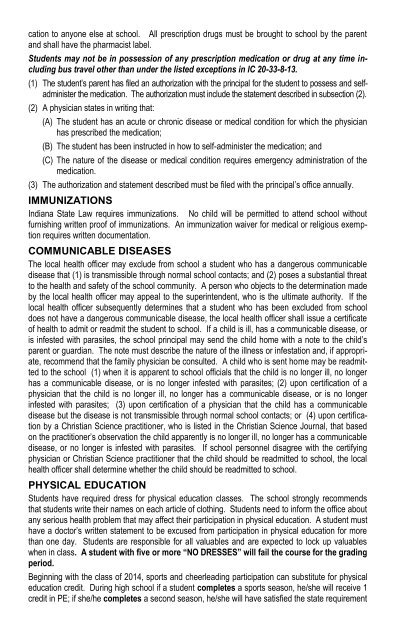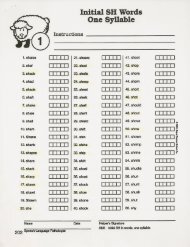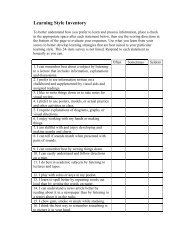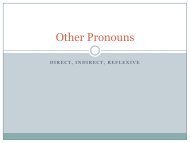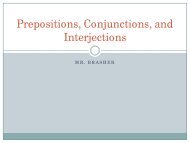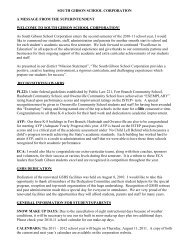Southern High School is a closed campus. - South Gibson School ...
Southern High School is a closed campus. - South Gibson School ...
Southern High School is a closed campus. - South Gibson School ...
You also want an ePaper? Increase the reach of your titles
YUMPU automatically turns print PDFs into web optimized ePapers that Google loves.
cation to anyone else at school. All prescription drugs must be brought to school by the parent<br />
and shall have the pharmac<strong>is</strong>t label.<br />
Students may not be in possession of any prescription medication or drug at any time including<br />
bus travel other than under the l<strong>is</strong>ted exceptions in IC 20-33-8-13.<br />
(1) The student’s parent has filed an authorization with the principal for the student to possess and selfadmin<strong>is</strong>ter<br />
the medication. The authorization must include the statement described in subsection (2).<br />
(2) A physician states in writing that:<br />
(A) The student has an acute or chronic d<strong>is</strong>ease or medical condition for which the physician<br />
has prescribed the medication;<br />
(B) The student has been instructed in how to self-admin<strong>is</strong>ter the medication; and<br />
(C) The nature of the d<strong>is</strong>ease or medical condition requires emergency admin<strong>is</strong>tration of the<br />
medication.<br />
(3) The authorization and statement described must be filed with the principal’s office annually.<br />
IMMUNIZATIONS<br />
Indiana State Law requires immunizations. No child will be permitted to attend school without<br />
furn<strong>is</strong>hing written proof of immunizations. An immunization waiver for medical or religious exemption<br />
requires written documentation.<br />
COMMUNICABLE DISEASES<br />
The local health officer may exclude from school a student who has a dangerous communicable<br />
d<strong>is</strong>ease that (1) <strong>is</strong> transm<strong>is</strong>sible through normal school contacts; and (2) poses a substantial threat<br />
to the health and safety of the school community. A person who objects to the determination made<br />
by the local health officer may appeal to the superintendent, who <strong>is</strong> the ultimate authority. If the<br />
local health officer subsequently determines that a student who has been excluded from school<br />
does not have a dangerous communicable d<strong>is</strong>ease, the local health officer shall <strong>is</strong>sue a certificate<br />
of health to admit or readmit the student to school. If a child <strong>is</strong> ill, has a communicable d<strong>is</strong>ease, or<br />
<strong>is</strong> infested with parasites, the school principal may send the child home with a note to the child’s<br />
parent or guardian. The note must describe the nature of the illness or infestation and, if appropriate,<br />
recommend that the family physician be consulted. A child who <strong>is</strong> sent home may be readmitted<br />
to the school (1) when it <strong>is</strong> apparent to school officials that the child <strong>is</strong> no longer ill, no longer<br />
has a communicable d<strong>is</strong>ease, or <strong>is</strong> no longer infested with parasites; (2) upon certification of a<br />
physician that the child <strong>is</strong> no longer ill, no longer has a communicable d<strong>is</strong>ease, or <strong>is</strong> no longer<br />
infested with parasites; (3) upon certification of a physician that the child has a communicable<br />
d<strong>is</strong>ease but the d<strong>is</strong>ease <strong>is</strong> not transm<strong>is</strong>sible through normal school contacts; or (4) upon certification<br />
by a Chr<strong>is</strong>tian Science practitioner, who <strong>is</strong> l<strong>is</strong>ted in the Chr<strong>is</strong>tian Science Journal, that based<br />
on the practitioner’s observation the child apparently <strong>is</strong> no longer ill, no longer has a communicable<br />
d<strong>is</strong>ease, or no longer <strong>is</strong> infested with parasites. If school personnel d<strong>is</strong>agree with the certifying<br />
physician or Chr<strong>is</strong>tian Science practitioner that the child should be readmitted to school, the local<br />
health officer shall determine whether the child should be readmitted to school.<br />
PHYSICAL EDUCATION<br />
Students have required dress for physical education classes. The school strongly recommends<br />
that students write their names on each article of clothing. Students need to inform the office about<br />
any serious health problem that may affect their participation in physical education. A student must<br />
have a doctor’s written statement to be excused from participation in physical education for more<br />
than one day. Students are responsible for all valuables and are expected to lock up valuables<br />
when in class. A student with five or more “NO DRESSES” will fail the course for the grading<br />
period.<br />
Beginning with the class of 2014, sports and cheerleading participation can substitute for physical<br />
education credit. During high school if a student completes a sports season, he/she will receive 1<br />
credit in PE; if she/he completes a second season, he/she will have sat<strong>is</strong>fied the state requirement


